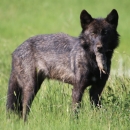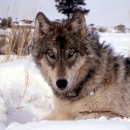September 15, 2023
News Release - USFWS releases final environmental impact statement & draft decision to designate a gray wolf experimental population in Colorado
-------------------------------------------------
Q: What are the differences between the draft documents and final versions in this announcement?
A: The final versions of these documents updated and clarified language and definitions. The final documents also include the addition of a provision to allow the take of gray wolves significantly impacting ungulate populations, as defined in the 10(j) rule, on Tribal reservation lands of the Ute Mountain Ute and Southern Ute Tribes within Colorado.
Q: Are there differences between the state of Colorado’s wolf management plan and the flexibilities provided in the federal 10(j) designation?
A: Colorado’s Parks and Wildlife Commission has published a Final Wolf Restoration and Management Plan for reintroducing the species. The state management plan provides for differing management tools based on achieving recovery targets. As the state achieves these recovery targets, tools available to the public under state laws and regulations may be more restrictive than what is allowable under the Service’s proposed federal rule. Instead of re-initiating the 10(j) process every time recovery targets are achieved, the Service is granting the state management authority aligned with the final targets. The public should become familiar with both federal and state laws and regulations. Colorado Parks and Wildlife can answer further questions about state laws and regulations.
Q: What will happen to gray wolves reintroduced in Colorado that leave the state?
A: The state of Colorado is working with surrounding states to discuss their plan to handle gray wolves that leave Colorado. The Service supports these efforts and anticipates continued close coordination with Colorado and the surrounding states. The Service’s support includes additional authorities to capture and relocate gray wolves that leave Colorado under a pending 10(a)(1)(A) permit. Any additional questions should be addressed directly by CPW, the agency conducting the reintroduction.
Q: Did the Service consider impacts on Mexican wolves?
A: The environmental impact statement considers possible impacts from the Colorado gray wolf 10(j) designation on Mexican wolves. The state of Colorado is in active discussion with surrounding states about how their reintroduced gray wolves will be managed as they cross state borders. The Service remains committed to recovering Mexican wolves and anticipates issuing a 10(a)(1)(A) permit to help avoid and minimize potential impacts to the species by allowing Colorado Parks and Wildlife to capture and relocate gray wolves that leave the state.
Q: What management flexibilities is the Service providing in the 10(j) experimental population designation?
A: The Service is designating a nonessential experimental population of gray wolves to provide additional management flexibility for Colorado Parks and Wildlife and Tribes to address potential conflicts between wolves and humans, and wolves and domestic animals. The designation of a nonessential experimental population allows reintroduced wolves to be managed by hazing, removal, or relocation by Colorado Parks and Wildlife, Tribes, or designated agent(s) for domestic animal depredations. Under special conditions and reporting requirements in the 10(j) rule, the public may harass or remove wolves attacking livestock or working dogs. Additional state-level requirements may apply and be more restrictive. The 10(j) rule extends additional management authority to the Ute Mountain Ute and Southern Ute Tribes to remove gray wolves that may be significantly impacting ungulate populations. Details about the conditions and requirements for the take of reintroduced wolves will be available in the final 10(j) rule the Service is publishing no sooner than 30 days after the draft ROD is announced.
Q: What are the next steps?
A: With the draft ROD and FEIS complete, the next step is for the Service to issue a 10(j) experimental population designation. This action will include publishing the Final ROD and the 10(j) rule itself no sooner than 30 days after this announcement is published in the Federal Register. The Service intends to publish the final ROD and 10(j) rule to be effective before the end of 2023.
Q: Is the U.S. Fish and Wildlife Service reintroducing wolves to Colorado?
A: No. On Nov. 3, 2020, Proposition 114, now codified as Colorado Statute 33-2-105.8, was approved by Colorado voters requiring the state of Colorado to reintroduce gray wolves by Dec. 31, 2023. Colorado Parks and Wildlife is the agency responsible for reintroducing wolves to Colorado. The involvement of the Service is related to ensuring appropriate management and management flexibility of the species, given their current status in Colorado as an endangered species under the Endangered Species Act. For more information about the state of Colorado’s reintroduction of gray wolves, including the Final Colorado Wolf Restoration and Management Plan, please visit the CPW Wolf Management page.
Q: What is a Section 10(j) designation?
A: The Service uses a range of partnerships and conservation tools to recover endangered and threatened species. Section 10(j) of the ESA allows the Service to designate a population of a listed species as experimental if it will be released into a habitat outside the species’ current range. A 10(j) rule would help CPW manage the potential impacts of gray wolf reintroduction to stakeholders while ensuring that the reintroduction and management of wolves are likely to be successful and contribute to the conservation of the species. Learn more about 10(j) rules and experimental populations.
Q: How can an experimental population be designated in Colorado where wolves already exist there?
A: Experimental populations must be separate from other populations of the species. While several documented wolves currently reside within northern Colorado, the definition of a population of gray wolves as defined by the Service requires two breeding pairs, raising at least two offspring for two consecutive years. The wolves present in northern Colorado have not met this definition of a population; thus, the Service can designate wolves reintroduced by the state of Colorado as an experimental population.
Q: Can the state of Colorado reintroduce gray wolves without the Service’s 10(j) experimental population designation?
A: Yes. The state could reintroduce gray wolves without the 10(j) experimental population designation, however, without management flexibility provided by the Service through a 10(j) designation, or other means, the state would be limited in its options to manage the federally endangered species appropriately. A 10(j) experimental population designation allows for the expanded management flexibilities noted above that would otherwise not be available. The Service is on track to issue a final 10(j) decision before the end of 2023.
Q: What is the current status of protections for gray wolves in the lower 48?
A: Following a February 2022 court ruling, gray wolves outside of the northern Rocky Mountains (Montana, Wyoming, Idaho, and portions of Washington, Oregon, and Utah) in the lower 48 are currently listed as endangered, except for Minnesota where they are listed as threatened. For the latest information on the status of the entity in the lower 48, please see the Service’s Gray Wolf Recovery News and Updates page.
-------------------------------------------------
December 7, 2023
Supplemental Q&As
Q: Who will be a designated agent under this rule?
A: The final rule defines a “designated agent” as an employee of a Federal, State, or Tribal agency who is authorized or directed by the Service to conduct management activities for the gray wolf consistent with the 10(j) rule (November 8, 2023, 88 FR 77036). Designated-agent status is memorialized in a memorandum of agreement (MOA) with the agency or Tribe which outlines the purpose, objectives, and roles and responsibilities of the Service and designated agent. The Service anticipates that a designated agent MOA with Colorado Parks and Wildlife will be final by mid-December of 2023. This MOA implements the Service’s authorization for the State of Colorado to release gray wolves as an experimental population under section 10(j) and to conduct management activities consistent with the 10(j) rule, subject to Service oversight.
Q: What is the current status of protections for gray wolves in Colorado in light of the 10j rule?
A: Because gray wolves introduced in Colorado are a nonessential experimental population under the 10(j) rule, gray wolves in the State of Colorado are managed as a threatened species (88 FR 77020). For the purposes of interagency consultation under section 7(a)(2), gray wolves on federally managed land in Colorado are treated as a species proposed for listing unless they occur in National Wildlife Refuges or units of the National Park Service, where they are treated as a threatened species (88 FR 77021).
Q: Is the experimental population of gray wolves in Colorado wholly separate geographically from nonexperimental populations of the same species?
A: Under section 10(j) of the ESA, an experimental population must be wholly separate geographically from nonexperimental populations of the same species. The purpose of this requirement is to ensure that existing populations of the same species (defined by the ESA as a species, subspecies, or distinct population segment (DPS)) receive the appropriate level of protection afforded to the species by its listing under the ESA. In other words, it ensures that the threatened status and special regulations issued under section 10(j) apply only to the designated experimental population and not to other populations of the same species. The Service carefully evaluates the best available scientific information to ensure that the experimental population is geographically separate from other populations of the species so that the designation does not result in reduced protections for existing populations.
For this experimental population designation, the ESA-defined term of the “species” under consideration is gray wolves listed as an endangered species in all or parts of 44 states (“44-State entity”) (see final rule reinstating ESA protections for gray wolves, Figure 1, 88 FR 75508, November 3, 2023). This species listing for the listed gray wolf species excludes (1) the delisted Northern Rocky Mountain distinct population segment (“NRM DPS”) (WY, MT, ID, and parts of OR, WA, and UT), (2) MN where gray wolves are listed as a threatened species, and (3) the portions of AZ and NM that are designated as an experimental population of Mexican wolves.
As shown in Figure 1 of the final 10(j) rule (88 FR 77018, November 3, 2023), populations of this species (44-State entity) occur in the western Great Lakes region in Wisconsin and Michigan, and in northern California, Oregon, and Washington. The distance between the nonessential experimental population in Colorado and other populations of the 44-State entity (the endangered population in the Great Lakes region (Wisconsin and Michigan) or the endangered populations in northern California, Oregon, and Washington) is well beyond the average dispersal distance of 60 miles (98.1 kilometers) for individuals (88 FR 77026). Thus, the Service concluded that an experimental population designation in Colorado would be wholly separate geographically from populations of gray wolves in the 44-State entity.
The Service also considered whether our designation would overlap with an existing population in Colorado. As noted in the rule (88 FR 77018, November 3, 2023), the two male gray wolves that have recently been documented in Colorado do not constitute a population of gray wolves (defined as two breeding pairs successfully raising at least two pups for two consecutive years). To date, no population of wolves has become established in Colorado.
Finally, the Service considered the likelihood of a population of gray wolves becoming established in Colorado by considering its separation from the unlisted NRM DPS of gray wolves, the mostly like source for wolves to disperse into Colorado. As noted in the final rule (88 FR 77026–77027, November 8, 2023), the distance to established gray wolf populations in the Greater Yellowstone area within the NRM DPS, as well as the predator management area in southern WY where packs are unlikely to persist, limits the ability for wolves from the Greater Yellowstone area to disperse into Colorado from Wyoming and makes the natural establishment of a population in Colorado unlikely. Because existing populations of the listed 44-State entity are well beyond the dispersal distance of wolves, and because no population of gray wolves occurs in Colorado or is likely to become established in the near future, the Service has concluded that an experimental population designated in Colorado would be wholly separate geographically from other nonexperimental populations of the listed gray wolf 44-State entity.
Q: Is the Colorado non-essential experimental population of gray wolves outside the current range of gray wolves in the lower 48 states?
A: Section 10(j) of the ESA states that release of an experimental population must be outside the current range of the species. The purpose of this requirement is the same as the requirement that experimental populations be wholly separate geographically: to ensure that nonexperimental populations receive the appropriate level of protection afforded to the species by its listing under the ESA. The terms “range” and “current range” can be defined differently in different contexts. For experimental populations, the Service considers an area to be outside of the current range of the species if there is no population of the listed species within the experimental population area.
As noted above, although two male gray wolves have been documented in Colorado as of June 2023 (88 FR 77018, November 8, 2023), these two wolves do not meet the definition of a “population.” Therefore, the nonessential experimental population in Colorado is outside the current range of the species, consistent with section 10(j)(2)(A).
Q: Does the nonessential experimental population designation for the gray wolf in the State of Colorado under section 10(j) of the Act “further the conservation” of the species?
A: The “species” for which the 10(j) rule designated an experimental population is the currently listed “endangered species” of gray wolves, the 44-State entity. As noted in the final rule (88 FR 77019, November 8, 2023), the gray wolf entity that is currently listed as endangered, to which the Colorado NEP belongs, includes all or parts of 44 states. The 44-State entity encompasses populations of gray wolves in the Great Lakes States of Michigan and Wisconsin as well as wolves outside the recovered, delisted NRM DPS in the Western U.S. 88 FR 75508. The Service used the conservation biology principles of resiliency, redundancy, and representation (the 3Rs) when considering the nonessential experimental population’s (NEP) contributions to the conservation of the endangered 44-State entity. In the final 10(j) rule, the Service found that establishing a new population in Colorado would contribute additional redundancy (multiple populations) and representation (geographic variation for adaptability) to the endangered species.
Additionally, the management flexibility provided in the 10(j) rule is expected to help address local, State, and Tribal concerns about wolf-related conflicts in Colorado, similar to those experienced in other NRM states (88 FR 77026, November 8, 2023). Congress added section 10(j) to the ESA in 1982 in an effort to reduce public resistance to efforts to reintroduce endangered species. Colorado Parks and Wildlife (CPW) identified social tolerance for wolves and economic impacts of their presence in the State as the most significant key elements for the future of wolf conservation and management in Colorado. The proposed reintroduction areas are working landscapes, meaning agricultural and ranching operations are an integral part of the landscape. There is high potential for controversy surrounding wolf conservation and management in Colorado if human interests and needs are not being addressed. To address stakeholder concerns, CPW requested the Service designate the gray wolf population that would be reintroduced to Colorado as experimental under section 10(j) of the ESA. Designating the population as experimental allows the Service to tailor ESA protections for the population to provide management flexibility and better address stakeholder concerns. Addressing these concerns proactively may result in greater human acceptance of gray wolves and other species of concern, which will also further the conservation of the species.






